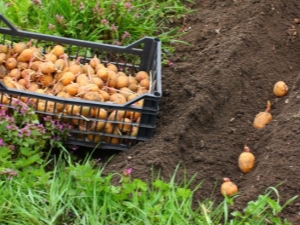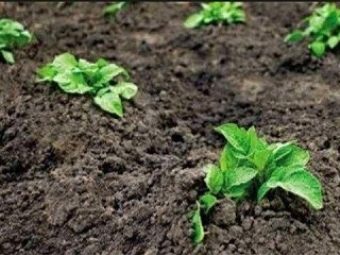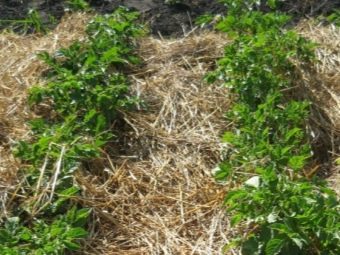Do I need to water the potatoes after planting?

The grass is green, the sun shines, gardeners and gardeners are drawn to their beloved cottages.And now the garden has been dug up, small planting tubers are already in the ground. And whether it is necessary to water the potatoes immediately after planting, we consider in the article.
Soil moisture - a criterion for watering
Experienced gardeners can say that it is not necessary to water immediately. But, in general, watering is needed.
However, we all know that every rule has exceptions. There are a number of factors to consider if you want a decent harvest. He is able to grow it not only to an experienced agronomist specialist, but also to a meticulous amateur gardener.
If the tubers were planted in a damp ground, then before the emergence of moisture sprouts the plant should suffice.
Often, summer residents make such a mistake: having heard somewhere that they do not water the potatoes after planting, they walk along empty beds, moisten the top layer of soil, and then plant the tubers with a clear conscience. So do not. After all, in fact, this is the same as watering immediately after you have planted potatoes.
Immediately after planting, the plant begins to form the root system. Naturally, the roots tend to moisture, that is, under normal conditions, the root system grows inwards, tending to the lower, more moist soil layers.
If you have generously watered the upper land layer, then the need to "look for" moisture disappears, the root system develops in breadth.
- An extensive, shallow and wide root system is a guarantee that the potato tubers grow the size of large peas.
- Shallow roots cannot independently extract moisture from the soil. Even a brief lack of rain and (or) watering can be fatal for plants.
Dry soil: landing guidelines
There is such a situation that the time to plant potatoes has come, and the ground is really very dry: dust and lumps. After all, it is clear: you will not collect a decent harvest from such a plot.
Try this method:
- we dig deep holes, one for each bush planted;
- in the hole pour at least a bucket of water;
- we wait until there is a full absorption of moisture;
- then sprinkle the hole with earth to the desired depth;
- plant potatoes.
Time and time for watering
The statement that this agriculture does not require watering is wrong. Yes, of course, before they planted huge gardens, nobody particularly followed the plantings, and everything grew. But the point here is the quality of the final product. With proper care and one weaving may well provide you with a winter supply. But small and ugly potatoes with tubercles and irregular growths do not please anyone, and the “correctness” of the potato shape, its weight and volume, directly depend on the growing conditions.
When the ground is dry, the tubers cease development, fall asleep. Then it rains, or suddenly the summer resident comes with a bright idea to water the garden, one part of the potato wakes up and starts to develop, and the other does not. As a result, tubers of irregular shape grow.
However, you can understand - when it's time to water. Dig a hole near the garden bed so that you can vertically lower your hand there completely. Lower it. If the fingertips are slightly wet after extraction, watering is not required; if dry, the plants need moisture.
Even in dry regions, watering is not done very often, but it should be abundant. Each bush requires at least three liters of water at a time. If the climate is not very favorable, there is a lack of humidity, one plant spends at least 60-70 liters of moisture per season. Waterlogging also negatively affects the growth of seedlings. If you already know about this feature of the soil of your plot, take care of the plants in advance - equip the drainage. During planting, you can also use the hydrogel, it will regulate the moisture of the soil, drawing in itself the excess when there is an excess of water and giving it away as needed.
Mandatory watering
At certain stages of plant development, potato beds usually require additional moisture.Of course, if the summer was rainy, the land is already wet, it is not necessary to turn the garden into a swamp. Make decisions about watering with an eye on climate conditions.
When the sprouts stretch over the soil for 5-10 centimeters, the bushes begin to form, it is possible for the first time to arrange watering for the potato beds.
If the lower leaves begin to fade, this indicates that there is not enough moisture in the soil.
The second mandatory irrigation is the period of budding and flowering. Then the tubers are tied, and the comfortable humidity contributes to the fact that there will be many tubers. For the third time, the potato beds are watered after flowering, when the tubers are intensively developed, and the correct watering helps to increase their weight and volume.
Now many cottages have running water. Please note that the "water from the tap" the potato is better not to water - it is usually too cold. Dial the required number in advance, let him warm a little. Watering with cold water can cause root rot.
Watering is best done in the morning or evening. It is preferable, however, in the evening, if the drops caught in watering the tops do not have time to dry, and the morning is hot and sunny, it is possible for the plant to get burned.
Loosening and mulching
Loosening is not for nothing called dry irrigation. It helps to preserve moisture, thereby increasing the intervals between additional soil moisture. When loosening, small capillary cracks are destroyed; these are conductors of moisture to the surface, where it evaporates. Dense soil reluctantly passes nutrients and air.
It is necessary to loosen the soil after any ingress of moisture, be it rain or watering. This measure allows you to avoid the appearance of compressed crusts on the surface and helps to better supply oxygen to the roots. There is no need to enthusiastically and deeply flush up the garden beds, it is quite enough to loosen it by 2–3 centimeters, in the process destroying the weeds that have crossed. Do this procedure carefully so as not to damage the tubers and tops.
Usually the first loosening, if there was no rain, is carried out approximately 7-10 days after planting. A layer of mulch from organic residues around the bush also helps preserve moisture.
Hilling
Hilling is the powder of the lower part of the plant bush with loose soil. A small mound appears to form around the bush. We will understand why this is necessary.
Hilling promotes faster plant development, improves soil ventilation.This is protection against reduced cold air. If the aboveground part of the plant is sick, hilling will prevent the infection from entering the tubers.
Sprout reached a height of 10-15 centimeters - it's time to pile up the potatoes for the first time. After 10-12 days we repeat the action. Hilling is then carried out as needed.
Top dressing
Good care is the key to a decent harvest, and care is not only watering and weeding, but also plant nutrition.
The timing of the first root feeding is the time of intense tops. Fertilizers are necessary if it can be seen that the bushes are stunted, frail, and poorly developed. You can use the following composition: for 10 liters of water, we take 1 tablespoon of urea or in a bucket of water we dilute half a liter of bird droppings or mullein.
The second time the plant can be fertilized during budding, preparing such a solution: 10 liters of water - 1 tablespoon of potassium sulfate and 3 tablespoons of wood ash. If there is no potassium sulfate, only wood ash can be dispensed with by preparing a solution at the rate of: 1 cup of ash per bucket of water.
During flowering the third dressing is carried out. Ingredients: in 10 liters of water we dilute 2 tablespoons of superphosphate and 1 cup of chicken manure or mullein. "Portion" of the compositions described for one bush is half a liter of solution.
How to water the potatoes, see the next video.





























